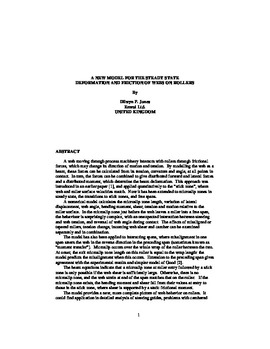| dc.contributor.author | Jones, Dilwyn P. | |
| dc.contributor.other | International Conference on Web Handling (2017) | |
| dc.date.accessioned | 2019-11-13T20:00:31Z | |
| dc.date.available | 2019-11-13T20:00:31Z | |
| dc.date.issued | 2017-06 | |
| dc.identifier | oksd_icwh_2017_jones | |
| dc.identifier.citation | Jones, D. P. (2017, June). A new model for the steady state deformation and friction of webs on rollers. Paper presented at the Fourteenth International Conference on Web Handling (IWEB), Stillwater, OK. | |
| dc.identifier.uri | https://hdl.handle.net/11244/322074 | |
| dc.description.abstract | A web moving through process machinery interacts with rollers through frictional forces, which may change its direction of motion and tension. By modelling the web as a beam, these forces can be calculated from its tension, curvature and angle, at all points in contact. In turn, the forces can be combined to give distributed forward and lateral forces and a distributed moment, which determine the beam deformation. This approach was introduced in an earlier paper [1], and applied quantitatively to the "stick zone", where web and roller surface velocities match. Now it has been extended to microslip zones in steady state, the transitions to stick zones, and free spans. | |
| dc.description.abstract | A numerical model calculates the microslip zone length, variation of lateral displacement, web angle, bending moment, shear, tension and motion relative to the roller surface. In the microslip zone just before the web leaves a roller into a free span, the behaviour is surprisingly complex, with an unexpected interaction between steering and web tension, and reversal of web angle during contact. The effects of misaligned or tapered rollers, tension change, incoming web shear and camber can be examined separately and in combination. | |
| dc.description.abstract | The model has also been applied to interacting spans, where misalignment in one span steers the web in the reverse direction in the preceding span (sometimes known as "moment transfer"). Microslip occurs over the whole wrap of the roller between the two. At onset, the exit microslip zone length on this roller is equal to the wrap length: the model predicts the misalignment when this occurs. Extension to the preceding span gives agreement with the experimental results and simpler model of Good [2]. | |
| dc.description.abstract | The beam equations indicate that a microslip zone at roller entry followed by a stick zone is only possible if the web shear is sufficiently large. Otherwise, there is no microslip zone, and the web strain at end of the span matches that on the roller. If the microslip zone exists, the bending moment and shear fall from their values at entry to those in the stick zone, where shear is supported by a static frictional moment. | |
| dc.description.abstract | The model provides a new, more complete picture of web behavior on rollers. It could find application in detailed analysis of steering guides, problems with cambered webs, and the occurrence of micro-scratches from steering - alone and in combination with tension changes. | |
| dc.format | application/pdf | |
| dc.language | en_US | |
| dc.publisher | Oklahoma State University | |
| dc.rights | In the Oklahoma State University Library's institutional repository this paper is made available through the open access principles and the terms of agreement/consent between the author(s) and the publisher. The permission policy on the use, reproduction or distribution of the article falls under fair use for educational, scholarship, and research purposes. Contact Digital Resources and Discovery Services at lib-dls@okstate.edu or 405-744-9161 for further information. | |
| dc.title | New model for the steady state deformation and friction of webs on rollers | |
| osu.filename | oksd_icwh_2017_jones.pdf | |
| dc.type.genre | Conference proceedings | |
| dc.type.material | Text | |
